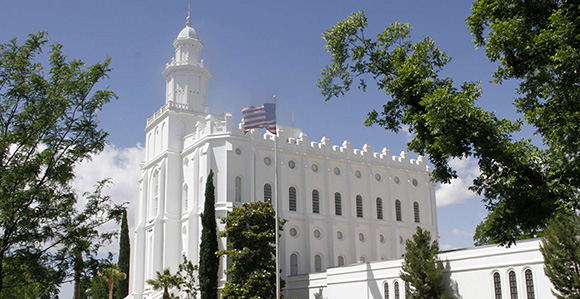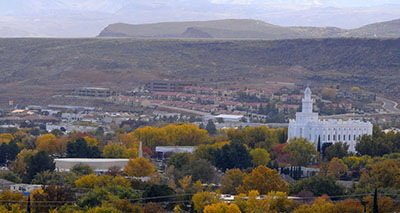Significant Temple Work Started at St. George Utah Temple
Contributed By By Jace Whatcott, Church News staff writer

The St. George Utah Temple is the oldest operating temple in the Church.
Article Highlights
- Wilford Woodruff made these “significant contributions” as president of the St. George Temple:
- 1. Endowments for the dead performed for the first time.
- 2. Proxy ordinances could be done by people other than direct descendants.
- 3. Signers of the Declaration of Independence appeared to Wilford Woodruff.
- 4. Repealed polygamy to save temples.
- 5. Repealed the law of adoption.
Elder Bruce C. Hafen, former president of the St. George Utah Temple and emeritus General Authority, gave a presentation titled “Brigham Young, Wilford Woodruff, and the St. George Temple” as part of the Evenings at the Museum series May 17 at the Church History Museum.
Elder Hafen began his presentation by expressing how close the St. George Utah Temple is to his heart. While growing up, Elder Hafen lived just four blocks from the temple. Remembering back to his childhood innocence, he said, “[The St. George Temple] was as familiar to me as my mother’s face.” As a child, he was able to feel a sense of safety and guidance because of the proximity of the St. George Temple, similar to the safety and guidance that a mother gives to her child.
Just 80 years before Elder Hafen was born, Brigham Young announced in general conference that 309 men would take themselves and their families to Utah’s Dixie area and create a new settlement. Elder Hafen said this was the first time that these men had been informed that they would be moving south, so among the crowd there was a “mix of emotions.”
Elder George A. Smith, counselor to Brigham Young, described the Dixie region as “the most wretched, barren, god-forsaken country in the world.” Ironically, the area that was void of kind words from Elder Smith was eventually named after him: St. George.
The Saints that settled the area struggled mightily. As many of today’s residents can attest, St. George was extremely dry, and the early settlers of the area dealt with starvation.
Despite the struggle to survive in the untamed Dixie area, in 1871, President Brigham Young announced that St. George would be home to a new temple. “Brigham Young knew that the 1,100 Saints that lived there were in extreme poverty,” said Elder Hafen. “But he also knew of their willingness to sacrifice.” The response to the daunting task in such dire circumstances was very characteristic of the Dixie Saints: “Glory Hallelujah!”
In what Elder Hafen described as “six back-breaking years,” the Saints completed the temple, bringing to the Dixie Saints a sanctuary where they could escape the troubles of life and enter the serenity of the Lord. Building a temple was so important to Brigham Young because he felt that he had been commissioned by the Prophet Joseph to “organize and systemize all [the] ceremonies.”
In addition to his devotion to the Prophet, a contributing factor that led to President Young’s desire to build temples was a feeling that his life was quickly coming to a close.
On his return trip, Brigham Young took a detour to dedicate the spot in Manti, Utah, where a temple would be built 13 years later.
Within months of his return to Salt Lake City, Brigham Young traveled to Logan, Utah, to dedicate the spot where the Logan Temple would be built. He died three months later.

St. George Utah Temple. Photo by Matt Gade, Deseret News.
The St. George Temple would prove to be one of three of the most important temples to be built in this dispensation. Elder Hafen explained that the temples in Kirtland, Nauvoo, and St. George were all necessary for bringing about the restoration of important priesthood keys and ordinances.
The Kirtland Temple was where Joseph Smith and Oliver Cowdery were given all necessary priesthood keys.
The Nauvoo Temple was the first temple in which baptisms for the dead were performed. While the first endowments were given in the upper room of the Red Brick Store and not in a temple, the principle of the endowment was introduced in the city of Nauvoo, and endowments for the living were later given on a large scale in the Nauvoo Temple before the exodus.
In 1877 the first endowments for the dead were performed in the St. George Temple, bringing about the restoration of all necessary ordinances for the living and the dead. Elder Hafen made note that it was in the St. George Temple that temple ordinances were put into a written form for the first time.
During his time as president of the St. George Utah Temple, Wilford Woodruff received revelations that would shape the way that Latter-day Saints worship and perform temple work today. Elder Hafen explained that President Woodruff made “significant contributions” to temple work.
1. Endowments for the dead were performed for first time.
The St. George Temple was the second temple where ordinances for the dead were performed, but endowments for the dead were first performed at the St. George Temple.
2. Proxy ordinances could be done by people other than direct descendants.
President Woodruff had names for female ancestors, but none of his female family members were available. He received a revelation that allowed non-descendants to do temple work for the dead. More than 100 women from the area helped him complete the work for the names that he had.
3. Signers of the Declaration of Independence appeared to Wilford Woodruff.
The founders of the United States, people who could be seen as facilitators of the Restoration, appeared to Wilford Woodruff and “demanded” that they receive their endowments.
4. Repealed polygamy to save temples.
With the threat of losing the temples to the U.S. government because of polygamy, Wilford Woodruff issued the Manifesto, repealing polygamy, which saved the temples from government possession.
5. Repealed the law of adoption.
In the early days of the Church, men would have themselves sealed to prominent Church leaders. Brigham Young, for example, was sealed to Joseph Smith. Wilford Woodruff did away with the practice in 1894.
